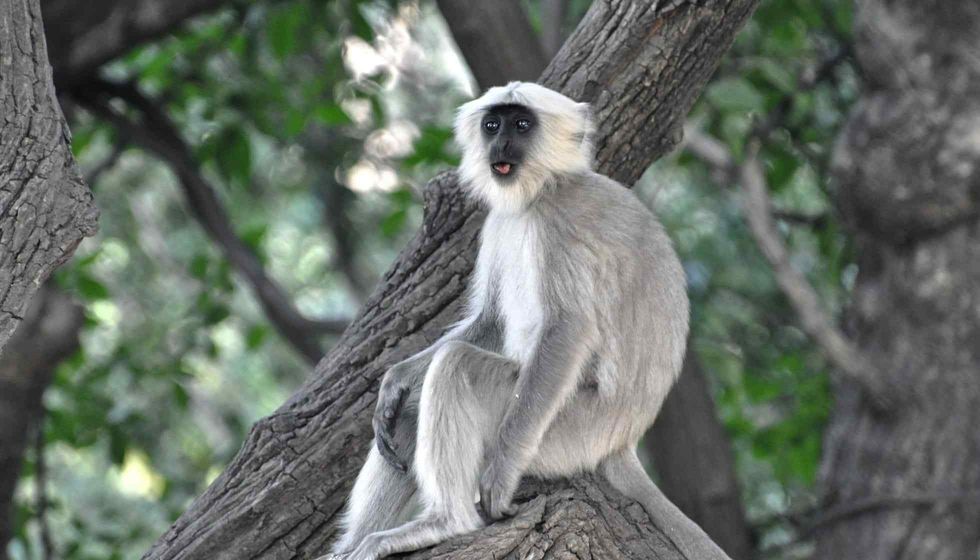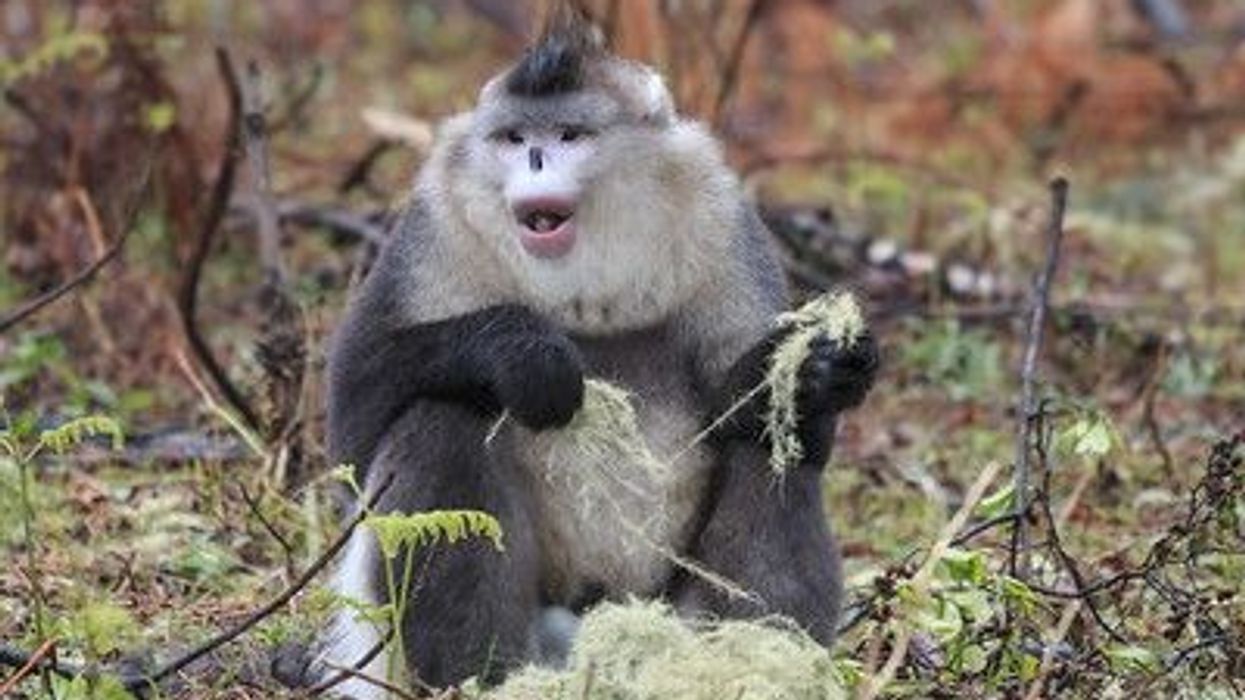Langurs are a type of diurnal monkey that are mostly arboreal by nature and love to live in groups. The Hanuman langur is one of the most famous species of langur found in India.
The genus that langurs fall under is called Semnopithecus, and many species that can be found in countries in Africa or in South Asia such as Vietnam, house species that are endangered.
These furry primates are spread across all of Asia and parts of Africa. They can be found in a range of habitats such as swamps, forests, mountains, deserts, and lowlands.
They are a part of the Cercopithecidae family, which translates to 'Old World Monkeys'.
Some of the most commonly known species include the Hanuman langurs, the gray langurs, the leaf monkeys, and the tufted gray langur. The Hanuman langur mingles in small groups, often known as troops, that have somewhere between seven and 10 members, and at times even 15 members.
Continue reading for more facts on langurs like Hanuman langurs. For information about other animals, take a look at colobus monkey and titi monkey facts too.
Langur Monkey Interesting Facts
What type of animal is a langur monkey?
Langurs are a type of herbivorous monkey that reside in trees deep in the forest.
What class of animal does a langur monkey belong to?
Langurs belong to the mammal class, the Semnopithecus genus, and are scientifically called Semnopithecus entellus.
How many langur monkeys are there in the world?
There isn't an exact statistic currently present that can comprehensively enumerate the current number of langur monkeys present in the world since there are so many species, each with its distinct conservation status.
Where does a langur monkey live?
They can be found in many primary and secondary tropical rainforests, where they will be most commonly found jumping from one tree to another. Langurs reside in forests, mountains, grasslands, and areas that are densely forested.
They are one of the few primates whose habitat varies so much as they can also be found in deserts, swamps, and lowlands. Langur monkeys can be found in various countries in Africa, as well as in countries in South Asia such as Bhutan, India, Vietnam, Sri Lanka, Bangladesh, Pakistan, and Nepal.
The subfamily that langurs belong to is called Colobinae.
There are many langurs present in the Indian subcontinent. Many Indian primates are well-known around the world.
What is a langur monkey's habitat?
Langur monkeys reside for most of their lives in the deep trenches of the forest among the treetops and on the ground. During the day, they are comfortable with staying on the ground. However, they always have a guard that looks out for predators. At night, they prefer to stay in the treetops to sleep and avoid predators.
Who do langur monkeys live with?
Langur monkeys stay together in packs called troops. Most troops include a dominant male and a mix of males, females, and offspring.
Others might only include male members. They become very territorial over their groups and resources and often show aggression or end up in fights to retain their precious commodities. When the dominant male changes in any group, there are many cases of infanticide by the new leader to showcase authority and dominance.
How long does a langur monkey live?
The average lifespan of a langue monkey is between the range of 20 to 30 years.
How do they reproduce?
In groups that only have a single male langur, it is the male that fathers all the offspring and breeds with all female primates. In groups that have multiple males, the highest-ranking male breeds with most females, and the rest of the hierarchy follows.
The gestation period of most langurs stays more or less in the same range, as most female langurs have a gestation period of 200 days.
Female langurs routinely give birth to a single offspring, but in some cases, they might even give birth to twins. The length between one birth to another is around two years.
What is their conservation status?
There are different conservation statuses for different species of langur, therefore, it is not possible to list a single conservation status for all langurs. However, according to the overall trend, the number of langur monkeys has been decreasing all over the world.
While some species of langurs are currently not endangered, many are.
Some of the most endangered species include the Delacour's langur monkey, the Francois langur monkey, the Douc langur monkey, the Kashmir Gray Langur, and the Western purple-faced langur. Fortunately, the gray langur monkey is one of the few species that is currently enlisted in the Least Concern category on the IUCN Red List for conservation.
Langur Monkey Fun Facts
What do langur monkeys look like?
Langurs have fur that is a shade of brown, black, red, or gray, with paler underparts. Some of these primates have markings on their head or legs resembling stripes. The color of their body helps them to hide from predators and to camouflage themselves.
Their feet and hands might be black, and they have long tails. Their slender limbs are very strong which helps them to survive in the forest canopy. The color of their young is generally different when they are born which makes adults more protective.
How cute are they?
Langur monkeys sometimes tend to be very cheeky and bold, and they have very playful energy. They tend to be warm, affectionate, and empathetic which makes them very cute. Many people find baby langurs to be extremely cute when they are born because of their tiny faces and limber bodies.
How do they communicate?
Langurs are very vocal creatures that have a variety of calls for different purposes. They have different calls for pointing out the danger, attracting a mate, directing anger, and voicing sadness.
The noises that they make are generally very loud and can be heard from very far distances. Some of these include grunts, rumbles, screams, hiccups, honks, coughs, harsh barks, and screeches.
How big is a langur monkey?
Langur monkeys have very long tails and lean chests. They seem like very big creatures to many people even though they are average when compared to most primates. Their bodies generally extend from anywhere between 16-31 in (41-79 cm), while their tails are 19.7-43.3 in (50-110 cm). Full-grown gorillas are almost thrice their size.
How fast can a langur monkey move?
Gray langurs, Hanuman langurs, and most other langurs move in a quadrupedal way. They use both their hands and feet to either walk or run.
Langurs love to run, walk, hop, swing, climb, and jump. When it comes to running, the more active langur monkey species are fast runners and can cover a large distance in a short period. They can even jump up to a length of 39 ft (12 m).
How much does a langur monkey weigh?
The weight of langurs can oscillate depending on the species, their head and body size, and their diet. There is a range for the weight distribution between different types of langur species.
In most cases, their weight lies between 12.1-33.06 lb (5.5-15 kg). Nepal gray langurs and the gray langur species also referred to as the Hanuman langur, are considered to be some of the largest primates present in Asia. On the other hand, the white-fronted langur is one of the smallest primates in the langur category.
What are the male and female names of the species?
There are no gender-specific names that are used to refer to males and females when it comes to the langur species. Many other primates also do not have different names for males and females.
What would you call a baby langur monkey?
Once they are born, there is no separate term for baby langurs. They are referred to as young babies, little langurs, or simply a langur monkey baby.
What do they eat?
Langurs are mainly herbivorous creatures that do not prey on any creatures or consume meat which is why some are called leaf monkeys. These primates love to munch on leaves, herbs, conifer seeds, fruits, shoots, seeds, bamboo, moss, crops, and other vegetation.
The only exception in their diet is that they might eat insects or their larvae. Leaf monkeys have a digestion system that is filled with bacteria that helps them break down all the different types of food that they eat.
Are they active?
These old-world monkeys are diurnal creatures, meaning they are mainly awake and active during the daytime. They tend to be gregarious and curious creatures that are always foraging through short distances in the forest to find food for themselves and their young.
They often travel in a group that has both males and females and tend to stay in the same habitat for the entirety of their lives. If these monkeys were placed in a habitat without any trees, they would have a really hard time adjusting.
Would they make a good pet?
As young males and females, these old-world monkeys may seem cute. However, as they grow older and their body gets bigger, they become more erratic and adventurous.
At this stage, they might need a lot more space, time, care, and resources that most human beings cannot provide at home. Since many langurs have long tails, big heads and bodies, and wandering hands and feet, they might end up damaging many items around the house and are not the kind of animal that should be domesticated.
Langur monkeys have also been known to bite, attack, and maim people.
They can be dangerous and should not be kept as pets. Some species also need conservation.
Did you know...
When a female langur from another group steals a langur infant from another group, the mother of the infant fights as hard as she can to get her child back, sometimes even going to the point of risking her own life.
What are the different types of langur monkeys?
There are somewhere around 159 species of langurs in the world. Some examples include the tufted gray langur, the Nepal gray langur, the southern plains langur, the black-footed gray langur, the northern plains gray langur, the Tarai gray langur, the Kashmir gray langur, the Nilgiri langur, and the purple-faced langur.
These monkeys mainly reside in a range of countries in South Asia, such as Bhutan, India, Vietnam, Sri Lanka, Bangladesh, Pakistan, and Nepal.
You may even spot them if you're trekking through forests or are in a lush landscape. They can be seen in northern Vietnam or northern India, as well as throughout many forests in the Asian subcontinent.
How do langur monkeys compare with other monkeys?
Langurs are a type of monkey known for their diurnal nature, long tail, and snappy behavioral antics. Many species of langurs are endangered and need to be kept in conservation.
In comparison to apes, leaf monkeys have a tail which is one thing that many apes do not have. Many langurs are kept to scare away other monkey species. For example, in many cities in India, langur monkeys are kept in captivity because they can scare away rhesus monkeys with their tail and bigger size.
Here at Kidadl, we have carefully created lots of interesting family-friendly animal facts for everyone to discover! Learn more about some other mammals including vervet monkeys or spider monkeys.
You can even occupy yourself at home by drawing one on our langur monkey coloring pages.










